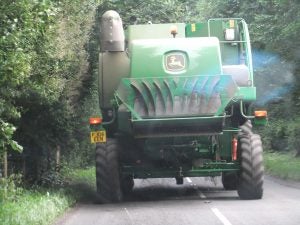The slogan says it all: “Sometimes, half the road is not enough.” When driving a combine between farms or hauling multiple round bales on a flatbed trailer, your farm equipment is at risk on the roadway. Reducing that risk takes effort on both the part of farmers and the other motorists.
In a small corner of Virginia, the enormous implications of safety were being discussed. Farmers and sheriff’s deputies, along with a few others, had their sights set on raising awareness. And being safe on the road involves more than just a caution sign on the back of your vehicle.
The group from Bedford County agreed that the responsibility for a safe ag environment is split:
- Part of it is on the motorists to drive a safe distance behind ag vehicles, to be aware of potential hazards, and not to recklessly pass while on blind curves or when there are solid yellow lines. A hazard “doesn’t have to be real big, just big enough to cause you to react or cause you to swerve, and before you know it, you hit somebody or run into a ditch,” said the county’s sheriff, Mike Brown.
- The other part of the equation is on the farmer to strap any loads onto the vehicle in accordance to commercial safety guidelines and to use appropriate signage and lights. If you don’t have turn signals on your vehicle, then be sure to use hand signals, even if they are something of lost art among today’s drivers.

“When we’re slowing down, motorists need to realize that it’s not always to let them pass,” said Amy Johnson with the Bedford County Farm Bureau Young Farmers. “We might be turning. When we’re turning off the road, that’s one of the most dangerous times for us.”
Virginia has a display used at various fairs that features a display of a standard-size road with a combine and a car placed on it. The size disparity is striking for those in the general public who may not be used to seeing them up close.
But size is only one part of the danger. Farmers might be hauling chemicals, pose fire hazards because of grain dust, or have moving parts on machinery that EMS teams might not be familiar with.
The lesson of the evening was to be proactive rather than reactive to safety around agricultural vehicles. The discussion went further into on-farm safety and how Fire/EMS crews might respond to an incident on a farm — assessing a situation, locating the scene of the emergency, and determining how to help.
“Their equipment is not going to cut that combine apart, no matter how hard they try,” Johnson said.
Johnson, who grew up farming 1,000 acres that had cattle and crops, said it was often hard to find someone in the various fields. Cellphone service was nonexistent then, and it’s unreliable in many places even today.
If an emergency cropped up, her dad could be on one of any eight farms.
“Trying to find him would be a big deal, and there were times when we couldn’t find him,” she said. Farmers are intent on mitigating those kids of risks.



